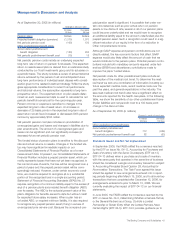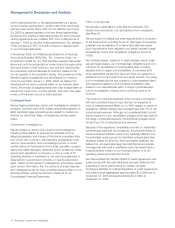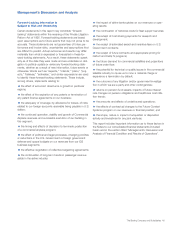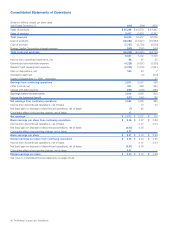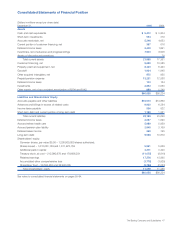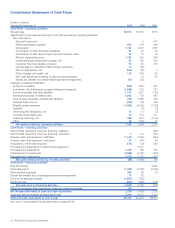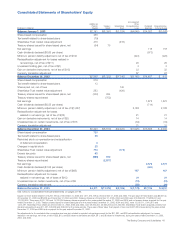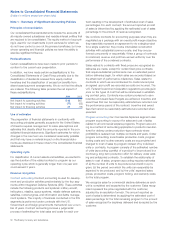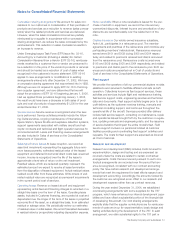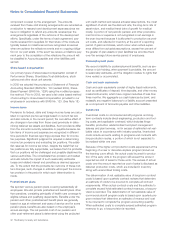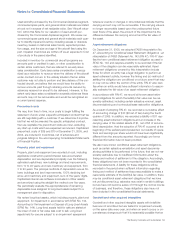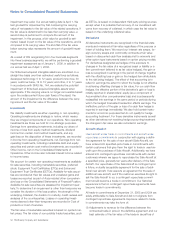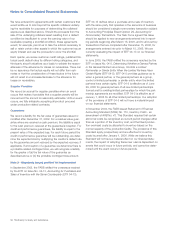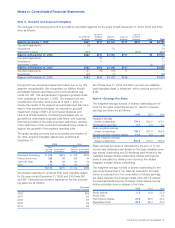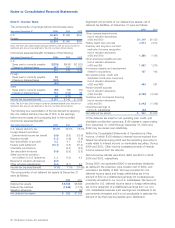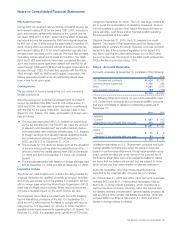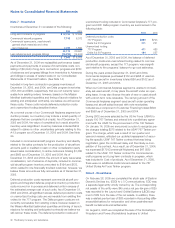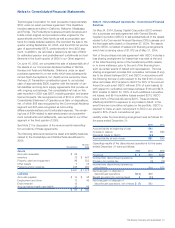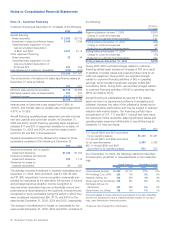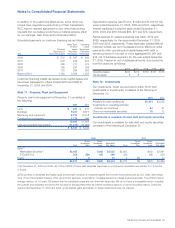Boeing 2005 Annual Report Download - page 55
Download and view the complete annual report
Please find page 55 of the 2005 Boeing annual report below. You can navigate through the pages in the report by either clicking on the pages listed below, or by using the keyword search tool below to find specific information within the annual report.Notes to Consolidated Financial Statements
Used aircraft purchased by the Commercial Airplanes segment,
commercial spare parts, and general stock materials are stated
at cost not in excess of net realizable value. See ‘Aircraft valua-
tion’ within this Note for our valuation of used aircraft pur-
chased by the Commercial Airplanes segment. We review our
commercial spare parts and general stock materials each quar-
ter to identify impaired inventory, including excess or obsolete
inventory, based on historical sales trends, expected produc-
tion usage, and the size and age of the aircraft fleet using the
part. Impaired inventories are written-off as an expense to Cost
of products in the period identified.
Included in inventory for commercial aircraft programs are
amounts paid or credited in cash, or other consideration to
certain airline customers, that are referred to as early issue
sales consideration. Early issue sales consideration is recog-
nized as a reduction to revenue when the delivery of the aircraft
under contract occurs. In the unlikely situation that an airline
customer was not able to perform and take delivery of the con-
tracted aircraft, we believe that we would have the ability to
recover amounts paid through retaining amounts secured by
advances received on aircraft to be delivered. However, to the
extent early issue sales consideration exceeds advances these
amounts may not be recoverable and would be recognized as
a current period expense.
Precontract costs
We may, from time to time, incur costs to begin fulfilling the
statement of work under a specific anticipated contract that we
are still negotiating with a customer. If we determine it is proba-
ble that we will be awarded the specific anticipated contract,
then we capitalize the precontract costs we incur, excluding
any start-up costs which are expensed as incurred. Capitalized
precontract costs of $39 and $70 at December 31, 2005, and
2004, are included in Inventories, net of advances and
progress billings in the accompanying Consolidated Statements
of Financial Position.
Property, plant and equipment
Property, plant and equipment are recorded at cost, including
applicable construction-period interest, less accumulated
depreciation and are depreciated principally over the following
estimated useful lives: new buildings and land improvements,
from 10 to 40 years; and new machinery and equipment, from
3 to 20 years. The principal methods of depreciation are as fol-
lows: buildings and land improvements, 150% declining bal-
ance; and machinery and equipment, sum-of-the-years’ digits.
Capitalized internal use software is included in Other assets
and amortized using the straight line method over five years.
We periodically evaluate the appropriateness of remaining
depreciable lives assigned to long-lived assets subject to a
management plan for disposition.
We review long-lived assets, which includes property, plant and
equipment, for impairment in accordance with SFAS No. 144,
Accounting for the Impairment or Disposal of Long-Lived Assets
(SFAS No. 144). Long-lived assets held for sale are stated at
the lower of cost or fair value less cost to sell. Long-lived
assets held for use are subject to an impairment assessment
whenever events or changes in circumstances indicate that the
carrying amount may not be recoverable. If the carrying value is
no longer recoverable based upon the undiscounted future
cash flows of the asset, the amount of the impairment is the
difference between the carrying amount and the fair value of
the asset.
Asset retirement obligations
On December 31, 2005, we adopted FASB Interpretation No.
47, Accounting for Conditional Asset Retirement Obligations - an
interpretation of FASB Statement No. 143 (FIN 47). FIN 47 clari-
fies the term conditional asset retirement obligation as used in
SFAS No. 143 and requires a liability to be recorded if the fair
value of the obligation can be reasonably estimated. Asset
retirement obligations covered by this Interpretation include
those for which an entity has a legal obligation to perform an
asset retirement activity, however the timing and (or) method of
settling the obligation are conditional on a future event that may
or may not be within the control of the entity. FIN 47 also clari-
fies when an entity would have sufficient information to reason-
ably estimate the fair value of an asset retirement obligation.
In accordance with FIN 47, we record all known asset retire-
ment obligations for which the liability’s fair value can be rea-
sonably estimated, including certain asbestos removal, asset
decommissioning and contractual lease restoration obligations.
As a result of adopting FIN 47, we recorded a cumulative effect
of accounting change of $10 ($6 net of tax) during the fourth
quarter of 2005. In addition, we recorded a liability of $11 rep-
resenting asset retirement obligations and an increase in the
carrying value of the related assets of $1, net of $5 of accumu-
lated depreciation. Had the adoption of FIN 47 occurred at the
beginning of the earliest period presented, our results of opera-
tions and earnings per share would not have been significantly
different from the amounts reported. Accordingly, pro forma
financial information has not been provided.
We also have known conditional asset retirement obligations,
such as certain asbestos remediation and asset decommis-
sioning activities to be performed in the future, that are not rea-
sonably estimable due to insufficient information about the
timing and method of settlement of the obligation. Accordingly,
these obligations have not been recorded in the consolidated
financial statements. A liability for these obligations will be
recorded in the period when sufficient information regarding
timing and method of settlement becomes available to make a
reasonable estimate of the liability’s fair value. In addition, there
may be conditional asset retirement obligations that we have
not yet discovered (e.g. asbestos may exist in certain buildings
but we have not become aware of it through the normal course
of business), and therefore, these obligations also have not
been included in the consolidated financial statements.
Goodwill and other acquired intangibles
Goodwill and other acquired intangible assets with indefinite
lives are not amortized but are tested for impairment annually
on the same date every year, and when an event occurs or cir-
cumstances change such that it is reasonably possible that an
The Boeing Company and Subsidiaries 53


